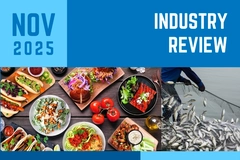
- Industry news
Industry news
- Category news
Category news
- Reports
- Key trends
- Multimedia
Multimedia
- Journal
- Events
- Suppliers
Suppliers
- Home
- Industry news
Industry news
- Category news
Category news
- Reports
- Key trends
- Multimedia
Multimedia
- Events
- Suppliers
Suppliers
Health-haloed offerings and gut health dominate dairy indulgence space, peg industry players

02 Mar 2022 --- Mindful indulgence, protein fortification, gut health and products with a health halo are dominating the dairy indulgent space, industry specialists reveal. Whey protein and dairy permeate are also enjoying sustained popularity.
Current dairy indulgence trends strongly draw on consumers’ response to the COVID-19 pandemic. To this effect, plant-based dairy has made significant growth in the category coupled with a strong theme of “nostalgia.” Provenance is another key focus of dairy indulgence, unlocking the potential of premiumization claims.
FoodIngredientsFirst speaks to Synergy Flavours, the US Dairy Export Council (USDEC), Barry Callebaut, Uelzena and Uflex, who dive into the key drivers and market dynamics in dairy indulgence.
Mindful indulgence trends
Synergy’s primary research indicates that adding a creamy taste and mouthfeel is of high importance for manufacturers of dairy products in creating an “indulgent eat.”

“In the current climate, recipe cost control and calorie reduction are two particular challenges developers are faced with and often dairy ingredient replacement is required to achieve these goals,” says Natalie Sheil, category manager, Synergy Flavours. A move toward plant-based ice cream is gaining traction.
A move toward plant-based ice cream is gaining traction.
“While consumers are seeking out comfort food, the pandemic has put more of a spotlight on health and its links with diet, so new products in this space will need to have a careful balance across health and indulgence attributes,” she says.
Plant-based dairy indulgence
Brands continue to witness a growing demand for indulgent plant-based alternatives. Barry Callebaut has developed a cocoa pairing toolkit that allows them to find the best cocoa to pair with a wide range of plant-based options, from rice to oat, almond and soy.
The company has pegged the consumer shift to plant-based indulgence as its #1 food trend this year.
“Consumers are looking for mindful treats that deliver great taste while being better for them and the planet. This is a long-term trend in the world of dairy indulgence, now we see that it is becoming mainstream with a growing number of flexitarian consumers choosing plant-based yogurts, drinks and desserts as a way to add variety to their diets,” explains Sofia Popova, EMEA marketing director, food manufacturers Barry Callebaut.
According to Synergy, while oat has led the way in NPD launches, the next plant-based trend will focus on sustainability and creating the ideal match to dairy’s health credentials. Pea and potato are two ingredients that are anticipated to gain popularity in 2022.
The next wave of plant-based dairy alternatives is expected to focus on sustainability and nutritional properties featuring ingredients such as potato and pea milk.
According to research by Synergy Flavours, 24% of consumers would like plant-based alternatives to taste more like traditional dairy products.
“Communicating the taste and indulgence aspects of plant-based alternatives will be key for brands to convince consumers to make the switch,” explains Sheil.
Younger demographic reach for vegan alternatives
Vegan alternatives without milk are most popular with younger consumers who value healthy eating.
“But for our company, this is still a niche. We have started a few projects, but we will certainly always remain a dairy processor first and foremost,” says Anja Brand, brand manager for Uelzena Ingredients. “By and by, all conventional dairy products will also be available as vegan alternatives.”
The combination of vegetable protein and dairy products is another avenue of interest for the company that will allow consumers to “taste the best of both worlds.”
Amit Shah, joint president & chief marketing officer, flexible packaging business, UFlex, says products based on soy milk, pea milk, rice milk, coconut milk, almond milk, cashew milk and oat milk are gaining traction and will continue to do so.
Consumers aged 17 to 26 lean strongly toward healthier lifestyle choices and reshape the demand for clean labels and plant-based products. Older consumers aged between 58 to 64, who typically consume many dairy products and milk, are increasing their spending on plant-based dairy due to having more disposable income.
“With consumers getting better with their food choices and conscious of living in a safer and cleaner environment, they are ready to adopt healthier eating habits via new variants of plant-based dairy and clean labels.”
Protein fortification According to USDEC, the demand for dairy product solids has grown significantly.
According to USDEC, the demand for dairy product solids has grown significantly.
The US dairy community can help meet current product demands for high-quality nutrition using whey protein and milk proteins, milk powders and permeate, reports USDEC.
“Many people may not be aware that whey proteins were created decades ago as an upcycled co-product of cheese making, turning what might have been waste into a nutrition-packed treasure. While whey proteins can be directly filtered from milk, whey protein production today remains primarily as a valuable co-product of cheese production,” says Vikki Nicholson-West, senior vice president, Global Ingredients Marketing at USDEC.
Protein additions within snacks are gaining strength, significantly enhancing mainstream protein bars to use premium inclusions and evolving shape and size formats, such as gourmet bonbons, she notes.
“The use of whey protein is expanding beyond the traditional sports nutrition and baby/toddler products to increase in cereals, bakery, desserts and snacks too,” she explains.
“With so many working or studying from home, snacking is booming.”
The rise of dairy permeate
Dairy permeate, also called dairy product solids, originates from making whey milk protein concentrates. The ingredient contains lactose and dairy minerals and “is quickly becoming a rock star in global food and beverages,” according to USDEC.
Over the past decade, the number of tracked new product introductions using permeate has soared, USDEC reports. “That is no surprise, given this ingredient’s multifaceted benefits, including its properties of flavor enhancement, sodium reduction, nourishing minerals, browning and cost savings,” comments Nicholson-West.
Focus on flavors
A renewed focus on planetary health drives demands for products carrying sustainability and ethical claims. Synergy reiterates that manufacturers are likely to tap into “health halo” ingredient claims such as protein fortification and gut health.
“In particular, we are seeing continued growth of the plant-based dairy alternative market as more consumers enter this category. The nostalgia trend shows no signs of slowing down as consumers look to food from the past as a source of comfort in challenging times,” explains Sheil.
Health halo flavors such as botanicals, florals, herbs and natural sweeteners such as honey and maple syrup are expected to feature across indulgent dairy products. Extracts and ingredients of origin, such as Sicilian lemon, will see a renewed focus.
“2022 will be all about taking those classic flavors and giving them a new lease on life with new formats and twists on flavor combinations. One example of a traditional product that has been given a new lease of life is the humble speculoos biscuit, which appears as a flavor profile across desserts, ice cream and bakery products, explains Sheil.
Consumers are spending more on premium ice cream than before the pandemic. Flavor and ingredient launches for ice cream remain popular and have seen significant innovations.
Flavor and ingredient launches for ice cream remain popular and have seen significant innovations.
In line with this, Barry Callebaut is developing preparations and sauces, cocoa and chocolate powders, and inclusions to add extra texture and flavor for yogurts and desserts.
“We are particularly proud of our wide range of chocolate stracciatella, a great way to create a multisensorial dairy experience, full of flavor and crunch,” adds Popova.
Premiumization on the rise
Provenance claims or taking inspiration from global recipes to provide consumers with “a sense of escapism” is growingly popular in dairy.
Sheil elaborates: “The key theme coming through in these spaces is premiumization as consumers look for small affordable treats in challenging times – ice cream, in particular, has seen a huge growth, with the average cost per 100ml of ice cream products increasing by 23% globally.”
Uelzena believes that the trend toward regionality remains strong alongside clean label claims.
Nostalgia continues to be a strong theme as brands look to transport consumers back to ‘simpler times’ such as their childhood represented by flavors of sticky toffee and apple pie, for example.
“Due to the pandemic, consumers have been spending much more time at home and have had to dramatically shift or curtail eating-out and travel habits,” says Nicholson-West.
“As a result, they have become especially hungry for guilt-free indulgence foods that elevate the enjoyment of eating experiences within the comfort of their own home and experientially deliver a culinary or taste/texture adventure while also fostering self-pampering,” she says.
“The search for intense indulgence is the other trend we observe: consumers keep looking for new textures and flavors, ultimately indulgent experiences. To answer this need, we see yogurts moving closer to ice cream, introducing flavors like caramel and nuts, adding crunchy inclusions to create a truly multi-sensory experience,” Popova outlines.
By Inga de Jong










